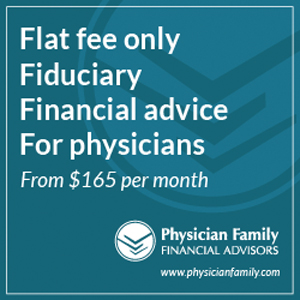(Want to meet me in person and attend my live lectures? Please join me next week at the White Coat Investor’s Financial Literacy and Wellness Conference, February 5-8, 2024, in Orlando, Florida. I will be giving two lectures at this amazing conference where I have spoken multiple times in the past. One lecture on Regaining the Joy of Being a Physician and the other on Living a Wealthy Life. If you have some of my books, bring them with you and get them autographed at my book signing event or catch me in the hall. There will also be books available to purchase on site. A few of you can even have dinner with me! Hope to see you there. If you want the information from this conference but can’t attend in person, there is a virtual option.)
(Today’s guest post comes to you from David Rosenstrock, who is a certified financial planner with an MBA and the Founder of Wharton Wealth Planning, LLC.)
As a physician it is easy to put your financial planning and retirement investing behind your day-to-day activities. It is important not to overlook where you are investing your monthly retirement contributions. Many doctors I have worked with were investing in retirement date funds because this was a ‘default’ investment selected for them. In many instances, this may not be optimal and can have a negative impact on your longer-term retirement account performance. We were recently quoted in an article in NASDAQ.com discussing some of the advantages and disadvantages of using target date funds for investments. We outline some of our thoughts below.
What is a target date fund?
A target date fund is a blend of stocks and bonds that is an all-in-one portfolio. These funds are designed to offer an appropriate allocation for the average investor relative to their anticipated retirement date. In other words, you’d pick a fund that aims for a retirement year closest to the year you’ll turn 65. For example, if you’re 40, you may pick a 2050 fund.
The high percentage of 401(k) participants with money in a target date fund is partly because it is often the default investment for employees who are automatically enrolled in a plan or whose plan changes hands after a merger.
Target date funds are designed to provide a simple investment solution through a portfolio whose asset allocation mix becomes more conservative as the target date (of retirement) approaches.
Why are target date funds used and how do they work?
The nice thing about investing your money in a target-date fund is that you really don’t have to do anything. Once you’ve opted for a target-date fund investment, a fund manager takes it from there and optimizes your investments based on the retirement date you give them. This strategy of investing in the target-date fund might seem sound, but is it really the best place to invest all of the money in your 401(k)?
What are some disadvantages of target date funds?
Even among the best target date funds, you can end up paying relatively high expense ratio fees relative to ETFs and other investments you may be able to choose from. This can have an outsized impact on your investment performance.
Target dates don’t allow you to separate different categories of investments (value stocks, growth stocks, bonds, etc). So in essence, you can’t rebalance or withdraw from investments that are doing well in certain years and avoid withdrawing from investments that are doing poorly in those same years. So the concept of ‘selling high’ can’t be met (as all your investments are in one large fund) and this can be a disadvantage of target date funds.
When you hit a certain age, you will have to take required minimum distributions and be forced to withdraw money whether you need it or not. When this happens being able to have more flexibility with what you want to sell and what you want to hold can prove to be a large advantage.
In addition, since target date funds often aggregate a lot of categories of investments together, they can include a larger percentage of certain asset categories (for example international stocks) than may be desired. So, it is important to understand and be aware of everything that the target date fund is investing in to make sure it suits your risk profile, goals, and needs. Not all target date funds have the same allocations and this can make a difference in the comparative long-term performance of one target date fund versus another.
With respect to target date funds the ‘target date’ should be set based on a number of factors including risk profile, liquidity, goals, and income/expense analysis. So individual circumstances need to be factored in and there is no one size fits all answer. An important question to ask when choosing among target-date funds: Is this a “to” fund, in which the allocation path freezes your asset allocation the year you plan to retire, or a “through” fund that continues the allocation path for 10 years or more past retirement before freezing your asset allocation. The philosophy of “through” funds is that life doesn’t stop at retirement. You still may have 20-30 years or more of living expenses, and the risk profile of a target date fund should reflect that with respect to the way they can allow your money to compound and grow.
It’s common for target date funds approaching retirement to use target date funds to, in essence, shift a larger portion of their investment portfolio to more secure income-producing investments, like bonds. Your final decade of working is when your portfolio is at its highest balance, and compound interest can really get to work for you. If you’re invested in a target date fund carrying 50% or more in bonds at that point, you’ll miss out on growth and have a less abundant retirement because of it. Unfortunately, safety comes at the price of reduced growth potential and the risk of erosion of value due to inflation. Safety at the expense of growth can be a critical mistake for those trying to build an adequate retirement funding strategy; target date funds don’t always do a great job at addressing this risk and element of investing.
When you hit a certain age you will have to take required minimum distributions and be forced to withdraw money whether you need it or not. When this happens being able to have more flexibility with what you want to sell and what you want to hold can prove to be a large advantage.
Some steps you can take to review your target date fund and retirement plan options
Before making a decision as to whether a target date fund is a good investment for your needs, check the fund’s fact sheet or prospectus to find out what the fund’s stated mission is, how it is currently allocated, and what its future path will be. Also remember to check the fund’s expense ratio since that will determine what you will pay in annual fees.
If you wish for more information, check out this article I was quoted in on NASDAQ.com titled Should You Keep Your Entire 401(k) in a Target-Date Fund.
David Rosenstrock, CFP®, MBA is the Director and Founder of Wharton Wealth Planning (www.whartonwealthplanning.com). He earned his MBA from the Wharton Business School and B.S. in economics from Cornell University. He is also a CERTIFIED FINANCIAL PLANNER™.






Excellent article. I was never a fan of target funds and the author makes a great point about RMD flexibility that corporate HR departments never mention when they present the 401k plan to employees. (I never thought of it either while working). My husband was talked into a target fund for his 401k and it took me over 10 years to dissuade him. We both had large , secure defined benefit pensions coming along with maximum Social Security and other investments . I wanted him to choose the S&P 500 index fund his plan offered. He finally did and later admitted he should have switched sooner.